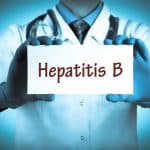Silymarin Improves Quality of Life During Hepatitis C Treatment
Over the past few decades, thousands of clinical studies have been conducted on the effectiveness of different types of complementary and alternative medicine (CAM) in combating chronic liver disease. As the CAM remedy most often advised and used to support liver health, silymarin supplementation has been the focus of a majority of these studies. Even though there is substantial evidence demonstrating silymarin’s benefits to a person with Hepatitis C, trial inconsistencies have prevented it from being totally accepted by the Western medical community. However, a recent result from a very large Hepatitis C clinical trial presents irrefutable evidence of silymarin’s value.
Silymarin
Milk thistle (Silybum marianum) has been used since Greco-Roman times as an herbal remedy for a variety of ailments, particularly liver problems. The active ingredient in milk thistle is known as silymarin. This substance, which actually consists of a group of compounds called flavonolignands, helps repair liver cells damaged by alcohol and other toxic substances. Silymarin also keeps new liver cells from being destroyed by these same substances, reduces hepatic inflammation and has potent antioxidant effects.
Most milk thistle products are standardized preparations extracted from the plant’s seeds. A majority of milk thistle preparations are standardized to contain 70 to 80 percent of silymarin. Since milk thistle products are dietary supplements in the U.S. and therefore not regulated, inconsistencies in concentration, purity and quality are the prime suspects for inconclusive clinical trial results.
CAM Frequency
As the aging population of Americans increasingly strives to take control of their health, their use of CAM rises correspondingly. Surveys show that in 1990, CAM was used by 34 percent of the U.S. population. In 1994, this frequency rose to 42 percent and up to 48 percent in 2004. Estimates show that Americans spend over $27 billion annually on CAM, a total that exceeds the amount spent on conventional medicines.
According to National Institutes of Health researchers, a significant portion of the subjects in the large-scale study evaluating Hepatitis C Antiviral Long-Term Treatment against Cirrhosis (HALT-C) were taking silymarin. Among 1,145 of HALT-C’s participants, the following statistics were noted:
- 56 percent had never taken herbal supplements
- 23 percent were using herbal supplements during the study
- Silymarin constituted 72 percent of the 60 types of herbal supplements used by participants
- Among all participants, 16 percent had used silymarin in the past
- Among all participants, 17 percent used silymarin at the beginning of the study
- Silymarin use correlated strongly with higher education
HALT-C Findings on Silymarin
The large trial investigating the effectiveness of long-term pegylated interferon therapy on Hepatitis C previous non-responders, HALT-C was concluded ineffectual for Hepatitis C management. Even though long-term administration of pegylated interferon did not slow the worsening of liver disease, researchers learned about an advantage of taking silymarin with interferon. With such a large portion of people with chronic Hepatitis C taking silymarin, the researchers looked to see if these individuals demonstrated any differences from their counterparts who were not taking an herbal supplement.
When comparing silymarin users to non-silymarin users in the HALT-C trial, the following was discovered:
- No beneficial effect of silymarin was found on ALT levels (serum alanine aminotransferases) – an enzyme often elevated with liver injury.
- No beneficial effect of silymarin was found on Hepatitis C virus RNA levels.
- Those on silymarin showed significantly fewer liver-related symptoms than non-users.
- Those on silymarin scored higher on quality-of-life parameters than non-users.
- After adjusting for age, race, education, alcohol consumption, exercise, body mass index and smoking, silymarin users showed significantly less fatigue, nausea, liver pain, anorexia, muscle and joint pain, and improvements in general health over non-users.
Confirming that silymarin has little direct effect on the Hepatitis C virus, the qualitative values generally used to evaluate virus severity were similar in silymarin users and non-users. However, there were other observable benefits to the silymarin users. By reducing the severity of common Hepatitis C symptoms and interferon side effects, silymarin use demonstrated an obvious advantage to people managing this virus.
Quality of Life
In reducing the liver symptoms of fatigue, nausea, liver pain, anorexia and muscle and joint pain, silymarin improves a person with Hepatitis C’s quality of life. In public health and in medicine, the concept of health-related quality of life refers to a person or group’s perceived physical and mental health. Physicians usually reference quality of life scales to measure the effects of how a chronic illness interferes with daily life.
Although quality of life is not a numerical measurement, many believe it to be the single most important factor in illness recovery.
A Pennsylvania study evaluated the importance of quality of life in patients with a specific type of advanced lung cancer. According to lead author Dr. Nicos Nicolaou, an attending physician in the radiation oncology department at Fox Chase Cancer Center in Philadelphia, “In the past, we’ve considered the stage of disease or tumor size along with other empirical data to predict how long a patient will survive, but now we know quality of life is a critical factor in determining survival.” Although this study focused on a different type of disease, a growing number of healthcare practitioners believe that enhancing a person’s quality of life improves the outcome of any type of chronic disease.
The most likely reason for CAM’s rising popularity is the increase in quality of life that many receive from its use. Although more research is required to prove that supplementing with silymarin improves the outcome of Hepatitis C infection, the mounting evidence leaves little room for doubt. The quality of life benefits that participants supplementing with milk thistle in the HALT-C trial experienced is enough to motivate most people managing this virus. If supplementing with this popular herb can significantly reduce fatigue, nausea, liver pain, anorexia, muscle and joint pain, and improve general health – it makes sense for people with chronic Hepatitis C to give it a try.
References:
Polyak, Stephen J., Inhibition of T-cell cytokines, hepatocytes NF-kappaB signaling, and HCV infection by standardized silymarin, Gastroenterology, May 2007.
Seeff LB, MD, et al., Herbal product use by persons enrolled in the hepatitis C Antiviral Long-Term Treatment Against Cirrhosis (HALT-C) Trial, Hepatology, January 2008.
Tickerhoff, L., et al., Alternative therapy use in liver transplant recipients, Progress in Transplantation, September 2006.
www.bloodindex.com, Hepatitis C Treatment Reduces the Virus but Serious Liver Problems May Progress, Bloodindex, November 2007.
www.cdc.gov, Health-Related Quality of Life, National Center for Chronic Disease Prevention and Health Promotion, 2008.
www.haltctrial.org, Complementary and Alternative Medicine (CAM) for
the Treatment of Chronic Liver Disease, Leonard B. Seeff, MD, HALT-C News, New England Research Institutes, January 2007.
www.hcvadvocate.org, Health Related Quality of Life and Hepatitis C, David Bernstein, MD, FACP, FACG, Hepatitis C Support Project, 2008.
www.hepatitisneighborhood.com, Quality of Life Important in Hepatitis Management, Physicians Stress, John C. Martin, CuraScript, Inc., 2008.
www.nlm.nih.gov, Quality of Life Predicts Lung Cancer Survival, Robert Preidt, HealthDay, ScoutNews LLC, October 2007.
www.umm.edu, Milk Thistle, University of Maryland Medical Center, 2008.







